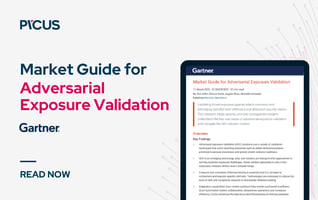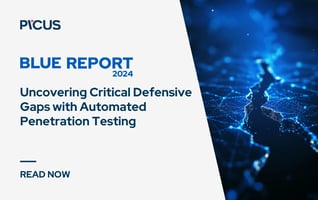Healthcare Cybersecurity in 2024: Building a Better Defence Against Rising Costs and Threats
Cybersecurity in the healthcare industry often faces a persistent and well-known dilemma. While the industry continues to be a major target for cybercrime, healthcare organizations have significant challenges in protecting sensitive patient data and maintaining continuity of operations with their limited budget. This blog discusses the state of cybersecurity in healthcare based on findings from the Picus Blue Report 2024, IBM's Cost of a Data Breach Report, and other leading sources to give actionable insights and help organizations enhance their defenses.
The State of Healthcare Cybersecurity
The healthcare industry remains the primary target for data breaches, with the average breach cost reaching as high as $9.77 million in 2024, according to an IBM report on the Cost of a Data Breach. This is a fall of 10.6% from the previous year but still puts healthcare ahead of all other industries regarding the damage and costs of a data breach. The HIPAA Journal estimates that data breaches in healthcare cost, on average, $408 per record, which is three times the average in other industries. This cost is further compounded by regulatory fines, class-action settlements, and reputational damage, highlighting that a resilient cyber defense is necessary for any care provider.
Considering these high stakes, let's look at how healthcare organizations performed in 2024 regarding security posture.
Effectiveness in Prevention: Signs of Progress
Prevention and detection effectiveness scores reflect an organization's capability to block and detect malicious actions, respectively. According to the Picus Blue Report 2024, the prevention effectiveness score in healthcare jumped 20%, from 56% in 2023 to 76% in 2024, driven by growing investments in security validation to help them improve their overall security posture.
While the healthcare sector has improved its prevention efforts, alert scores reveal a concerning trend. Even with improvements in log scores, alert scores dropped from 23% to 5%, indicating an increasing separation between log collection and actionable alerts. Without proper detection mechanisms, critical threats may go unnoticed, thus leaving healthcare organizations exposed.
Considering the critical stakes in healthcare cybersecurity, it's essential to assess how prevention measures have progressed and how they tie into the broader security strategy.

Ransomware: A Persistent Threat
Ransomware attacks impact healthcare organizations disproportionately, considering the confidentiality of Protected Health Information (PHI) data they handle and the disruption in business continuity. From a financial perspective, ransomware incidents in healthcare are among some of the costliest cyberattacks, with most costing over $1 million to recover from. The rise of ransomware demonstrates the need for robust detection and response strategies that complement prevention efforts.
According to the Picus Red Report, ransomware and other malware strains showed a 333% growth in "hunter-killer" techniques designed with the purpose of disabling security controls. These types of threats underpin the necessity to adopt proactive cybersecurity for defensive capabilities to outpace adversarial methods and techniques. In the words of Dr. Suleyman Ozarslan, Co-founder of Picus Security, such malware variants work like "ultra-evasive submarines," making their detection and prevention vital. These types of attacks further emphasize the need for proactive measures and continuous validation to stay ahead of adversaries."
Proactive Ways to Enhance Ransomware Defenses
To effectively fight ransomware, healthcare organizations have to shift from reactive to proactive cybersecurity approaches by:
- Identifying and mitigating potential vulnerabilities in your environment before they are exploited.
- Optimizing all elements and processes of the detection engineering, from log collection to alert mechanisms in SIEM and EDR systems.
- Deploying effective backup and recovery solutions and regularly practicing ransomware attack simulations to develop better response strategies.
Validating security controls helps healthcare providers maintain a proactive outlook on the unyielding threat of ransomware and other advanced adversarial tactics. At the end of this article, comprehensive suggestions for improving overall security posture, including ransomware readiness, will be mentioned.
Bridging the Log-Alert Gap
The widening gap between log scores at 60% and alert scores at 5% indicate a rapidly growing concern in the healthcare sector.While effective logging gives organizations the much needed visibility into threats, detective security controls are underutilized in turning collected logs into meaningful detection alerts. The gap between the log scores and alert scores must be responded to by continuously validating logging and alerting systems to match real-world threat scenarios.
Healthcare organizations should focus on:
- Ensuring that logs are comprehensive and validated.
- Improving prioritization of alerts through AI filtering noise and highlighting critical threats.
- Testing detection rules are triggering consistently appropriate alerts.

Recommendations for Healthcare Organization
Addressing these gaps requires actionable strategies that healthcare organizations can implement immediately. Healthcare institutions should focus on the items below to enhance threat detection and prevention.
1. Implement Continuous Threat Exposure Management (CTEM)
CTEM allows healthcare organizations to take a more proactive approach to cybersecurity, simulating real-world attack scenarios that identify vulnerabilities and inform remediation efforts. Continuous validation of the security posture enables healthcare providers to reduce risk and increase resiliency.
2. Address the Skills Shortage
The vulnerability of healthcare is compounded by the cybersecurity skills gap. Such a gap in cybersecurity skills can be overcome by investment in training programs for existing staff or outsourcing security operations to MSSPs.
3. Rationalize Cybersecurity Investments
According to the Picus Blue Report, organizations that validate their security controls before investing in new technologies realize better ROI. Healthcare cybersecurity leaders must prioritize exposure validation to ensure the investment made so far is effective and map new spending based on actual needs.
4. Enhance Ransomware Defenses
With the increased threat of ransomware, healthcare organizations need to:
- Establish good backup and recovery processes.
- Adopt advanced endpoint detection and response (EDR) tools.
- Conduct simulated ransomware attacks to enhance response capabilities.
By validating security controls and maintaining a proactive approach, healthcare firms can better combat the persistent threat of ransomware and other advanced adversarial tactics.
Conclusıon
Building Resilient Healthcare Cybersecurity
The challenges in healthcare cybersecurity, from the rising costs of data breaches to the persistent ransomware threat, highlight the urgent need for proactive and comprehensive defense strategies. While prevention scores in healthcare have improved, the widening gap between log and alert scores reminds us that detection and response mechanisms must grow alongside adversarial tactics.
To build a resilient cybersecurity posture, healthcare organizations must adopt Continuous Threat Exposure Management, strengthen ransomware defenses, and rationalize their cybersecurity investments. By validating and optimizing their security controls, they can protect sensitive patient data, maintain operational continuity, and ultimately ensure trust in the care they provide.
With a proactive mindset and a commitment to innovation, the healthcare sector can meet the cybersecurity challenges of 2024 head-on and secure its place as a defender of patient safety and privacy.








